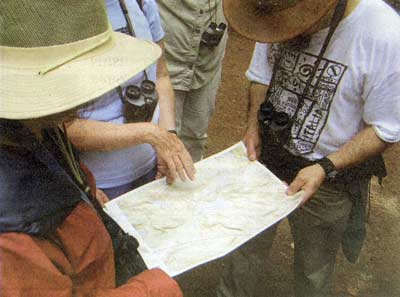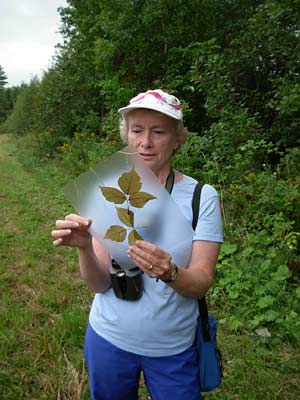Not this past weekend but the weekend before, Sept. 6 it must have been, Arlene and I went on a guided nature walk at the Sabbathday Lake Shaker village. That’s the last Shaker community left that’s a going concern. There are four Shakers right now, two elderly women, one middle-aged man (one other man was part of the community two years ago, but has gone out into the world since) and one younger woman who joined recently.
One of the eight people on the walk was a reporter for a local newspaper, one of the papers that you can pick up free at the supermarket, the Gray-New Gloucester Independent. Naturally we wanted to read the article, but we hadn’t expected that our picture would be in the paper:

That’s my leather hat from Fort Hall and my Rome T-shirt on the right, Arlene’s hat and red parka on the left, and the tour guide’s hand pointing to the map.
This turned out to be a nature walk where most of the participants had something to contribute. We pointed out a couple of birds. The reporter, Don Perkins, knew a lot about trees and about the history of the area. The guide was very good on wildflowers and details of the history of the Shaker property and talked about her trip to the monarch butterfly overwintering area in Mexico and her experiences working for the North American Bluebird Society. Another woman was a wildlife biologist with a sharp eye out for frogs and toads, and another man spotted all the blackberries and huckleberries within range.
Our guide, Carol Beyna, had brought a sample of poison ivy safely ensconced between two sheets of clear contact paper. Although I thought I was good at identifying it, I learned a couple of fine points from her.

Notice that the petiole (stem) of the middle leaflet is longer than that of the two side leaflets. The two side leaflets are not symmetrical about their central vein. There’s a sort of purplish dot where the three petioles meet. If you get close enough to see that, I hope you’ve been careful where you were walking!